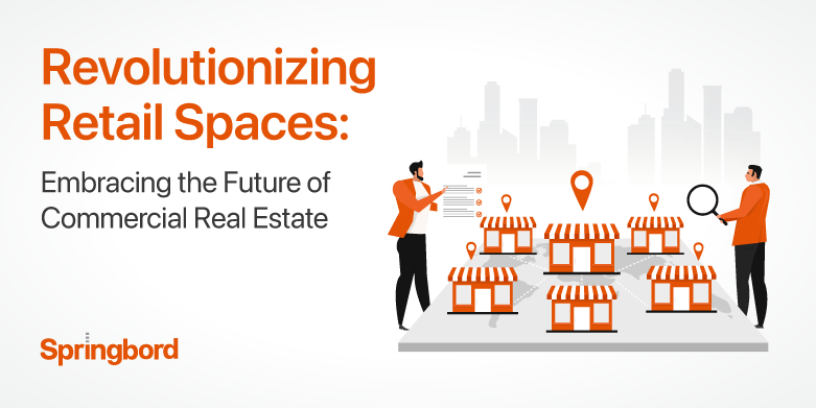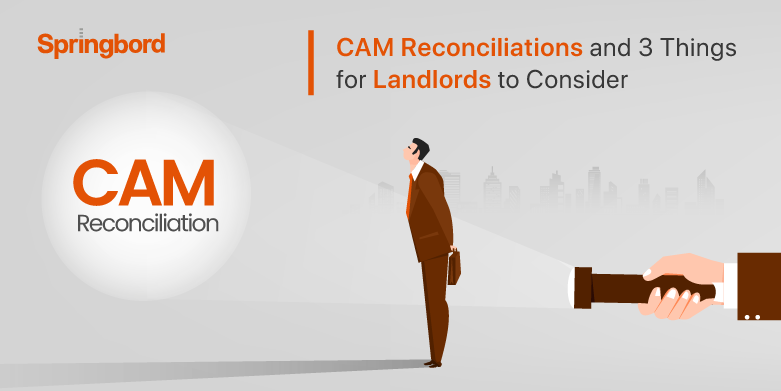 Read time 4 min
Read time 4 minIntroduction
In recent years, the commercial real estate sector, particularly retail, has undergone a significant transformation. Once perceived as nearing extinction, brick-and-mortar retail spaces have evolved, adapting to new challenges and opportunities. This evolution has been partly driven by the rise of e-commerce and changing consumer preferences, further accelerated by the COVID-19 pandemic. In this blog, we’ll explore how commercial real estate is adapting and what the future holds, particularly focusing on the innovations and strategies employed by companies like Springbord.
The Evolution of Retail Spaces
For years, industry analysts have predicted the demise of physical retail spaces. However, these forecasts were premature. Instead of extinction, retail has undergone a remarkable evolution. The advent of e-commerce, accelerated by the COVID-19 pandemic, has compelled brick-and-mortar stores to rethink their strategies. Notably:
- E-Commerce Influence: The rise of e-commerce led to a significant increase in retail closures. In 2020, 30 major retailers filed for bankruptcy, and around 9,500 stores closed. E-commerce necessitates more logistics and warehouse space, often three times that of traditional retail. For instance, in 2020, firms in the U.S. leased 21% more logistics space than the previous year, and Amazon expanded its fulfillment network by an unprecedented 50%.
- Adaptation and Innovation: Retailers are adapting by embracing the “clicks-to-bricks” approach, integrating online and offline experiences. The pandemic further popularized models like “buy-online-pickup-in-store” (BOPIS) and curbside pickup, with giants like Target and Walmart successfully implementing these strategies.
- Malls and Shopping Centers: These have been particularly impacted. Repurposing dead space into warehouses is a trend, but it often doesn’t yield strong returns for shopping centers. Instead, malls are exploring transformations into microdistribution centers, community gathering spots, or multifamily housing developments, offering new community opportunities.
- Revised Rental Agreements: The pandemic-induced economic downturn led to complex rental situations. However, this prompted a shift in lease negotiations, with tenants and landlords seeking mutually beneficial terms, such as lower rents for extended lease terms and incorporating creative elements like force majeure clauses and shared services models for BOPIS solutions.
Technological Integration in Retail Spaces
As we further explore the evolving dynamics of commercial real estate, the role of technology cannot be overstated. In this digital age, retail spaces are not just physical locations but also digital platforms. Integrating technology into retail experiences is becoming increasingly crucial. This includes:
- Digital Experiences On-Site: Retail spaces are transforming from mere points of sale to customer engagement hubs. By integrating digital experiences, such as augmented reality (AR) and virtual reality (VR), retailers are enhancing in-store experiences, thus bridging the gap between online and offline worlds. This shift not only attracts consumers but also serves as a powerful tool for customer acquisition.
- Data-Driven Decisions: Leveraging data analytics is vital for understanding consumer behavior and preferences. Retailers are using insights from data to tailor experiences, manage inventory more effectively, and optimize store layouts.
- Smart Building Technologies: The adoption of smart building technologies in commercial properties is on the rise. These technologies improve operational efficiency, energy management, and maintenance processes, contributing to sustainability and cost savings.
Advancing Towards a Digital-First Retail Environment
Harnessing E-Commerce and Omnichannel Strategies
In the latter half of this exploration into the transformative future of commercial real estate, it’s crucial to recognize the increasing dominance of e-commerce and the emergence of omnichannel strategies. Retailers are now focusing on creating a seamless shopping experience that integrates both online and offline channels. This trend includes:
- Omnichannel Retailing: Offering a consistent and integrated shopping experience across various platforms is vital. This approach includes synchronized online and in-store inventories, unified customer service, and a cohesive brand experience.
- E-Commerce as a Catalyst for Physical Retail: Rather than seeing e-commerce as a threat, forward-thinking retailers are using it as a tool to drive traffic to their physical stores. This includes leveraging online platforms for marketing, customer engagement, and as a preview of the in-store experience.
Sustainability in Retail Real Estate
Sustainability is becoming a key consideration in the commercial real estate sector. Eco-friendly practices are not only beneficial for the environment but also increasingly attractive to consumers and tenants. This shift towards sustainability includes:
- Green Building Practices: Implementing eco-friendly construction methods and materials, energy-efficient systems, and waste reduction practices.
- Sustainable Operations: Ongoing efforts to minimize the environmental footprint of retail spaces, such as using renewable energy sources, implementing recycling programs, and promoting sustainable transportation options for customers and employees.
The Future Landscape of Retail Real Estate
The landscape of retail real estate is set for further evolution, driven by technological advancements, changing consumer preferences, and a focus on sustainability. Key trends to watch include:
Commercial real estate service providers are crucial in helping property owners adapt to these trends. Key trends to watch include:
- Experiential Retail: Moving beyond transactional experiences, retail spaces are increasingly focusing on creating memorable, immersive experiences that draw customers in and encourage repeat visits.
- Flexible and Multipurpose Spaces: The trend of flexible and multipurpose spaces allows for a variety of uses, adapting to changing market demands and consumer trends.
- Community-Centric Developments: Retail spaces are increasingly being integrated into mixed-use developments that serve as community hubs, combining shopping, dining, entertainment, and residential units.
The Role of Property Management Services
In the context of these changes, property management services play a crucial role. Companies like Springbord offer specialized services that are crucial for navigating the complexities of the modern commercial real estate landscape. Their expertise includes:
- Lease Administration: Effective lease administration is key to maintaining profitable and compliant retail spaces. This involves negotiating favorable terms, managing lease renewals, and ensuring regulatory compliance.
- Building Maintenance and Operations: Regular maintenance and efficient operations are essential for retaining tenants and ensuring their satisfaction. Property management services provide expertise in managing these aspects, ensuring the smooth functioning of retail spaces.
- Tenant Relationship Management: Building and maintaining strong tenant relationships is central to the success of commercial real estate. Property managers act as liaisons between property owners and tenants, fostering communication and addressing concerns promptly.
Conclusion
The future of commercial real estate, particularly retail, is bright and full of potential. By embracing the changes and leveraging the opportunities presented by e-commerce, sustainability, and technology, property owners and retailers can create spaces that are not only profitable but also valuable to the communities they serve. As a partner in your journey, Springbord is committed to providing the expertise and services you need to succeed in this transformative era.
Discover how Springbord can help you transform your commercial real estate portfolio for a prosperous future. Visit us here to learn more about our services and how we can support your goals.







